PPMP20012: Exploring Organizational Factors in Project Management
VerifiedAdded on 2023/06/11
|10
|2670
|215
Essay
AI Summary
This essay provides a comprehensive analysis of various organizational factors that significantly influence project management. It delves into general systems management, highlighting the interconnectedness of subsystems and their impact on project success. The importance of organizational structure in defining stakeholder roles and preventing conflicts is discussed, along with an overview of functional structures. The essay also examines risk management, emphasizing risk identification, mitigation strategies, and the integration of business continuity planning. Furthermore, it explores portfolio management, focusing on investment decisions and the role of organizational maturity, assessed using the CMMI model. The essay concludes by reiterating the importance of these organizational factors in ensuring project success and adaptability.
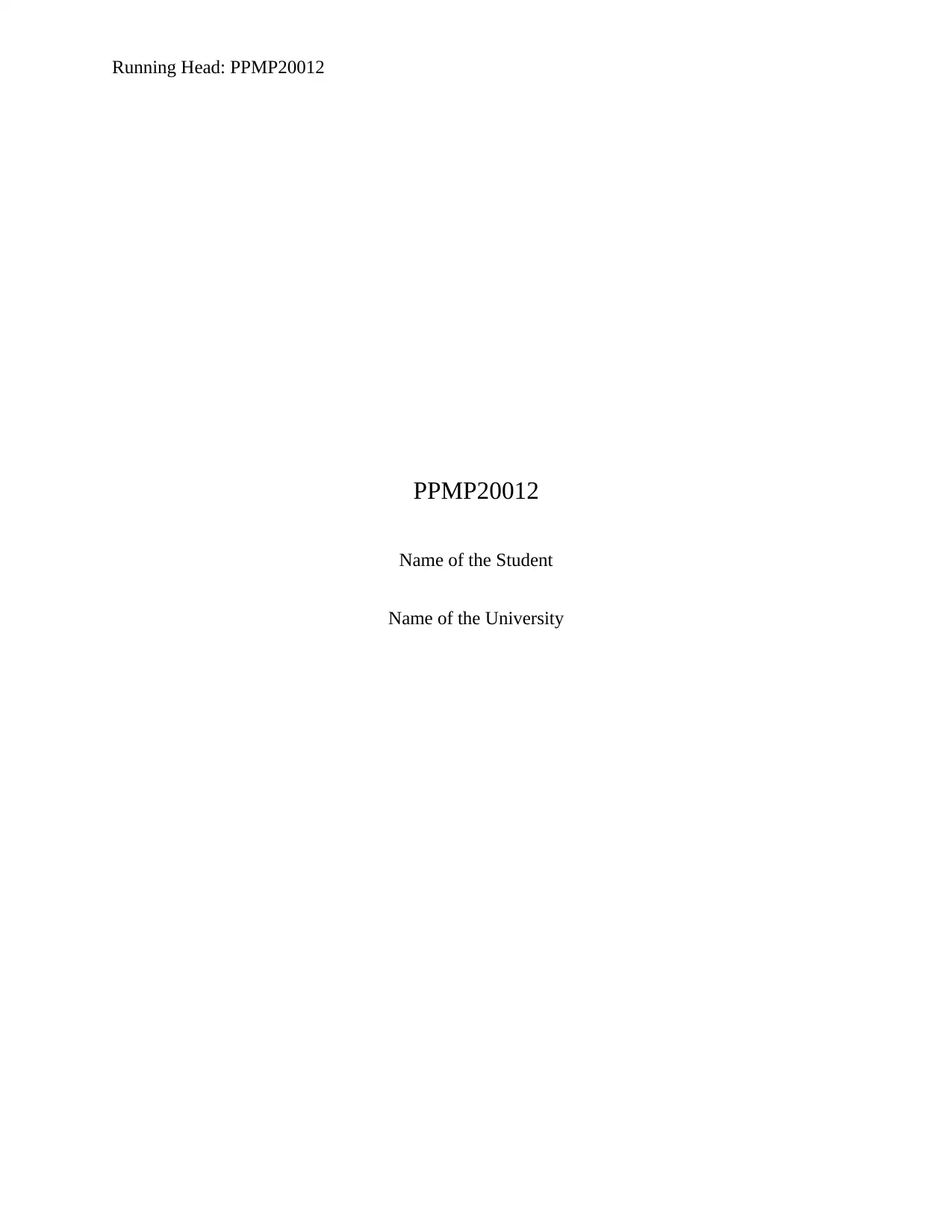
Running Head: PPMP20012
PPMP20012
Name of the Student
Name of the University
PPMP20012
Name of the Student
Name of the University
Paraphrase This Document
Need a fresh take? Get an instant paraphrase of this document with our AI Paraphraser
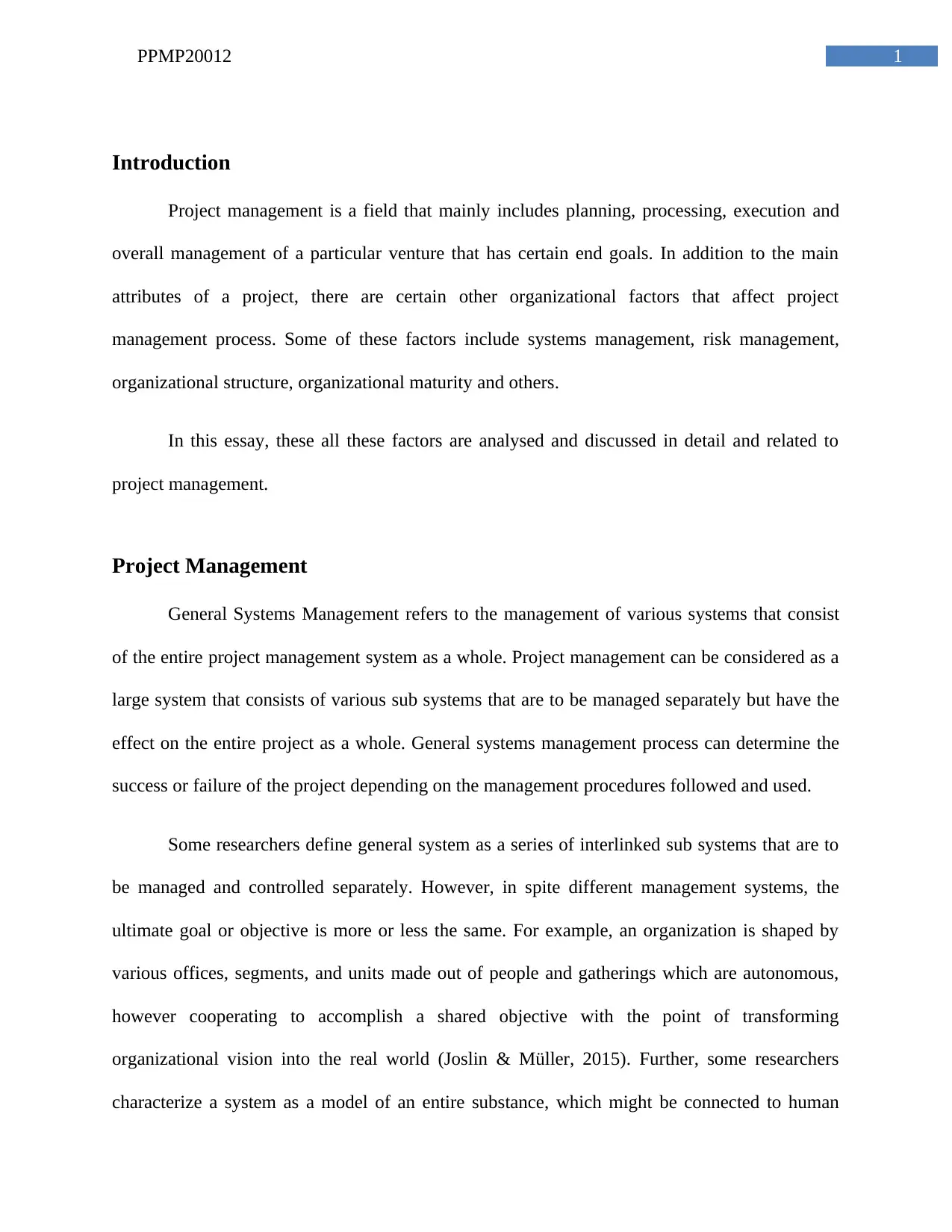
1PPMP20012
Introduction
Project management is a field that mainly includes planning, processing, execution and
overall management of a particular venture that has certain end goals. In addition to the main
attributes of a project, there are certain other organizational factors that affect project
management process. Some of these factors include systems management, risk management,
organizational structure, organizational maturity and others.
In this essay, these all these factors are analysed and discussed in detail and related to
project management.
Project Management
General Systems Management refers to the management of various systems that consist
of the entire project management system as a whole. Project management can be considered as a
large system that consists of various sub systems that are to be managed separately but have the
effect on the entire project as a whole. General systems management process can determine the
success or failure of the project depending on the management procedures followed and used.
Some researchers define general system as a series of interlinked sub systems that are to
be managed and controlled separately. However, in spite different management systems, the
ultimate goal or objective is more or less the same. For example, an organization is shaped by
various offices, segments, and units made out of people and gatherings which are autonomous,
however cooperating to accomplish a shared objective with the point of transforming
organizational vision into the real world (Joslin & Müller, 2015). Further, some researchers
characterize a system as a model of an entire substance, which might be connected to human
Introduction
Project management is a field that mainly includes planning, processing, execution and
overall management of a particular venture that has certain end goals. In addition to the main
attributes of a project, there are certain other organizational factors that affect project
management process. Some of these factors include systems management, risk management,
organizational structure, organizational maturity and others.
In this essay, these all these factors are analysed and discussed in detail and related to
project management.
Project Management
General Systems Management refers to the management of various systems that consist
of the entire project management system as a whole. Project management can be considered as a
large system that consists of various sub systems that are to be managed separately but have the
effect on the entire project as a whole. General systems management process can determine the
success or failure of the project depending on the management procedures followed and used.
Some researchers define general system as a series of interlinked sub systems that are to
be managed and controlled separately. However, in spite different management systems, the
ultimate goal or objective is more or less the same. For example, an organization is shaped by
various offices, segments, and units made out of people and gatherings which are autonomous,
however cooperating to accomplish a shared objective with the point of transforming
organizational vision into the real world (Joslin & Müller, 2015). Further, some researchers
characterize a system as a model of an entire substance, which might be connected to human
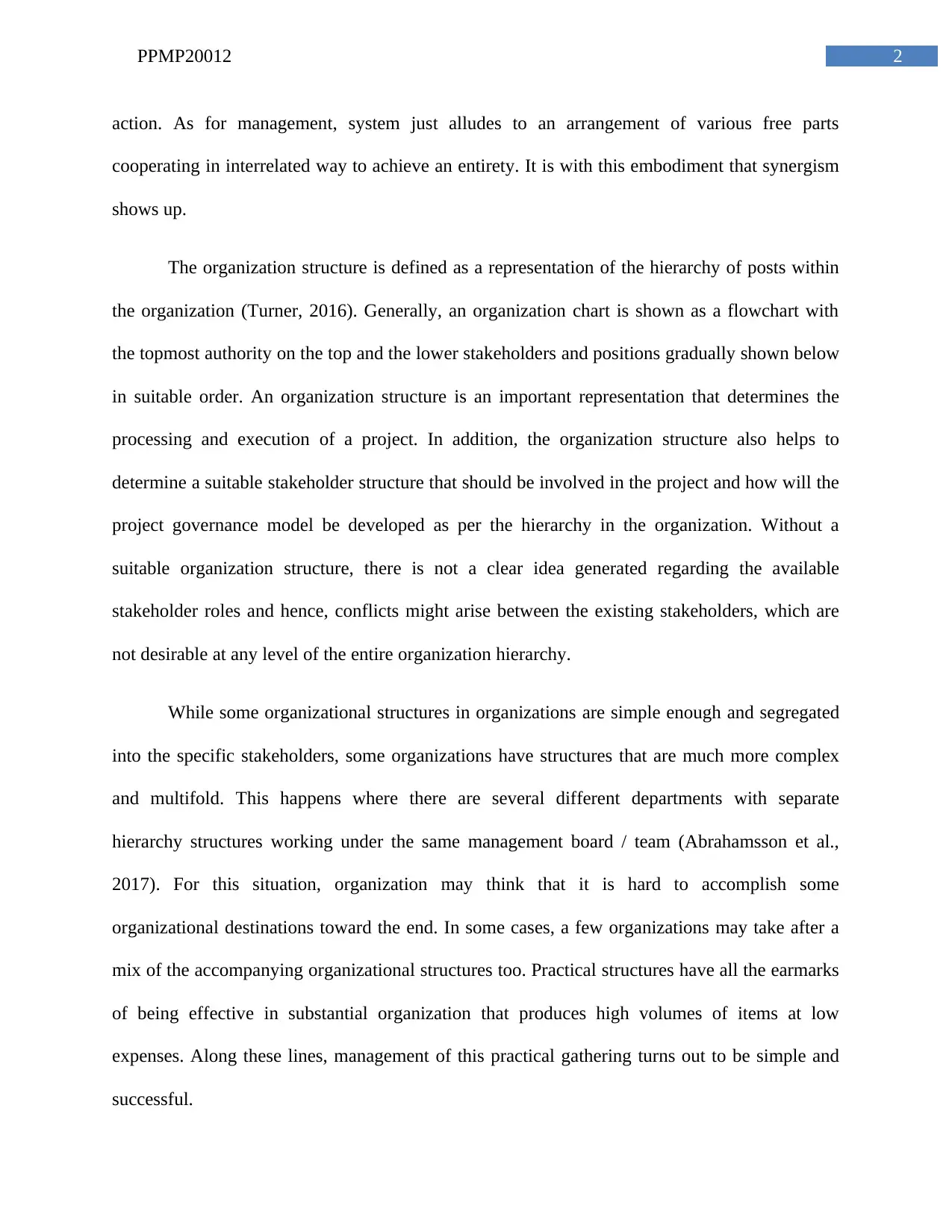
2PPMP20012
action. As for management, system just alludes to an arrangement of various free parts
cooperating in interrelated way to achieve an entirety. It is with this embodiment that synergism
shows up.
The organization structure is defined as a representation of the hierarchy of posts within
the organization (Turner, 2016). Generally, an organization chart is shown as a flowchart with
the topmost authority on the top and the lower stakeholders and positions gradually shown below
in suitable order. An organization structure is an important representation that determines the
processing and execution of a project. In addition, the organization structure also helps to
determine a suitable stakeholder structure that should be involved in the project and how will the
project governance model be developed as per the hierarchy in the organization. Without a
suitable organization structure, there is not a clear idea generated regarding the available
stakeholder roles and hence, conflicts might arise between the existing stakeholders, which are
not desirable at any level of the entire organization hierarchy.
While some organizational structures in organizations are simple enough and segregated
into the specific stakeholders, some organizations have structures that are much more complex
and multifold. This happens where there are several different departments with separate
hierarchy structures working under the same management board / team (Abrahamsson et al.,
2017). For this situation, organization may think that it is hard to accomplish some
organizational destinations toward the end. In some cases, a few organizations may take after a
mix of the accompanying organizational structures too. Practical structures have all the earmarks
of being effective in substantial organization that produces high volumes of items at low
expenses. Along these lines, management of this practical gathering turns out to be simple and
successful.
action. As for management, system just alludes to an arrangement of various free parts
cooperating in interrelated way to achieve an entirety. It is with this embodiment that synergism
shows up.
The organization structure is defined as a representation of the hierarchy of posts within
the organization (Turner, 2016). Generally, an organization chart is shown as a flowchart with
the topmost authority on the top and the lower stakeholders and positions gradually shown below
in suitable order. An organization structure is an important representation that determines the
processing and execution of a project. In addition, the organization structure also helps to
determine a suitable stakeholder structure that should be involved in the project and how will the
project governance model be developed as per the hierarchy in the organization. Without a
suitable organization structure, there is not a clear idea generated regarding the available
stakeholder roles and hence, conflicts might arise between the existing stakeholders, which are
not desirable at any level of the entire organization hierarchy.
While some organizational structures in organizations are simple enough and segregated
into the specific stakeholders, some organizations have structures that are much more complex
and multifold. This happens where there are several different departments with separate
hierarchy structures working under the same management board / team (Abrahamsson et al.,
2017). For this situation, organization may think that it is hard to accomplish some
organizational destinations toward the end. In some cases, a few organizations may take after a
mix of the accompanying organizational structures too. Practical structures have all the earmarks
of being effective in substantial organization that produces high volumes of items at low
expenses. Along these lines, management of this practical gathering turns out to be simple and
successful.
⊘ This is a preview!⊘
Do you want full access?
Subscribe today to unlock all pages.

Trusted by 1+ million students worldwide
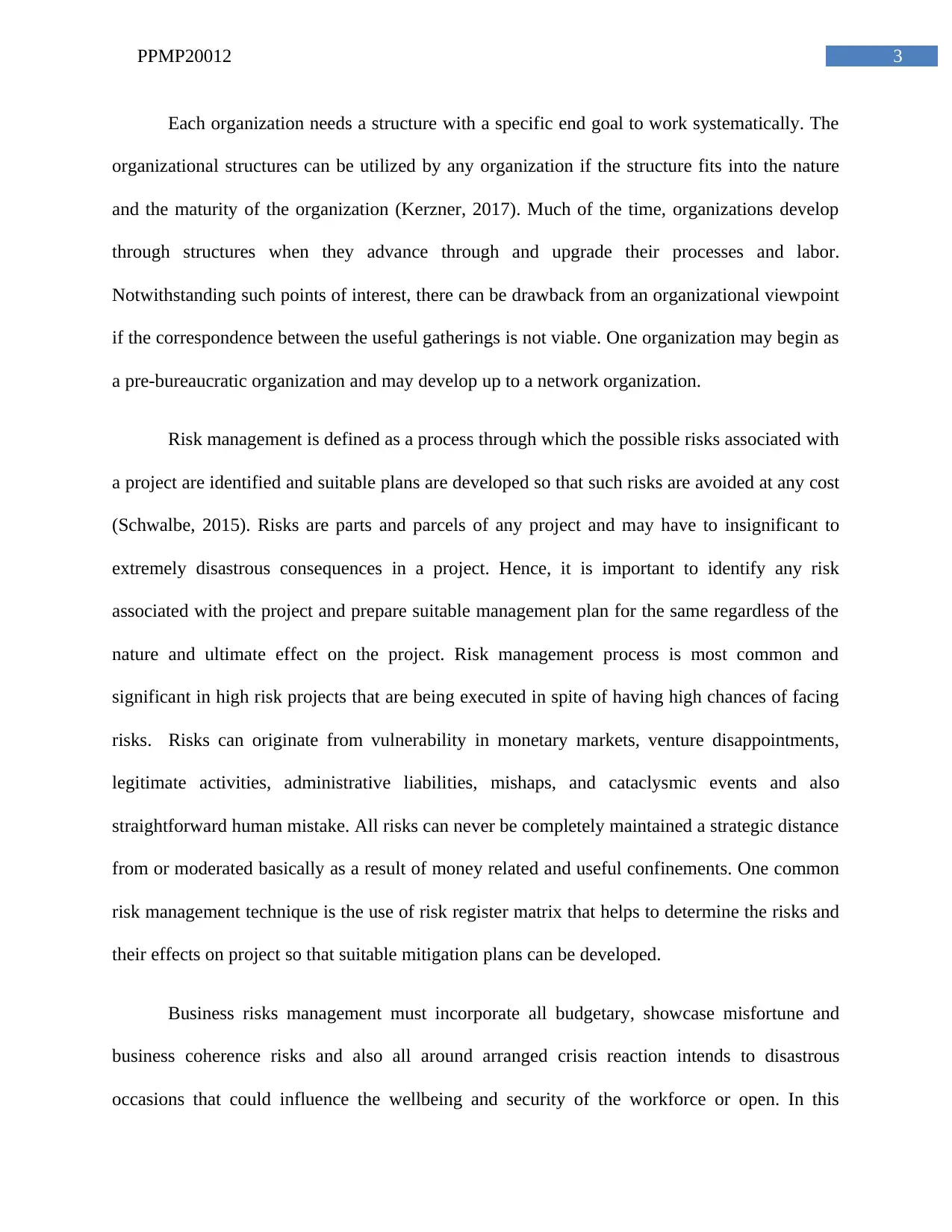
3PPMP20012
Each organization needs a structure with a specific end goal to work systematically. The
organizational structures can be utilized by any organization if the structure fits into the nature
and the maturity of the organization (Kerzner, 2017). Much of the time, organizations develop
through structures when they advance through and upgrade their processes and labor.
Notwithstanding such points of interest, there can be drawback from an organizational viewpoint
if the correspondence between the useful gatherings is not viable. One organization may begin as
a pre-bureaucratic organization and may develop up to a network organization.
Risk management is defined as a process through which the possible risks associated with
a project are identified and suitable plans are developed so that such risks are avoided at any cost
(Schwalbe, 2015). Risks are parts and parcels of any project and may have to insignificant to
extremely disastrous consequences in a project. Hence, it is important to identify any risk
associated with the project and prepare suitable management plan for the same regardless of the
nature and ultimate effect on the project. Risk management process is most common and
significant in high risk projects that are being executed in spite of having high chances of facing
risks. Risks can originate from vulnerability in monetary markets, venture disappointments,
legitimate activities, administrative liabilities, mishaps, and cataclysmic events and also
straightforward human mistake. All risks can never be completely maintained a strategic distance
from or moderated basically as a result of money related and useful confinements. One common
risk management technique is the use of risk register matrix that helps to determine the risks and
their effects on project so that suitable mitigation plans can be developed.
Business risks management must incorporate all budgetary, showcase misfortune and
business coherence risks and also all around arranged crisis reaction intends to disastrous
occasions that could influence the wellbeing and security of the workforce or open. In this
Each organization needs a structure with a specific end goal to work systematically. The
organizational structures can be utilized by any organization if the structure fits into the nature
and the maturity of the organization (Kerzner, 2017). Much of the time, organizations develop
through structures when they advance through and upgrade their processes and labor.
Notwithstanding such points of interest, there can be drawback from an organizational viewpoint
if the correspondence between the useful gatherings is not viable. One organization may begin as
a pre-bureaucratic organization and may develop up to a network organization.
Risk management is defined as a process through which the possible risks associated with
a project are identified and suitable plans are developed so that such risks are avoided at any cost
(Schwalbe, 2015). Risks are parts and parcels of any project and may have to insignificant to
extremely disastrous consequences in a project. Hence, it is important to identify any risk
associated with the project and prepare suitable management plan for the same regardless of the
nature and ultimate effect on the project. Risk management process is most common and
significant in high risk projects that are being executed in spite of having high chances of facing
risks. Risks can originate from vulnerability in monetary markets, venture disappointments,
legitimate activities, administrative liabilities, mishaps, and cataclysmic events and also
straightforward human mistake. All risks can never be completely maintained a strategic distance
from or moderated basically as a result of money related and useful confinements. One common
risk management technique is the use of risk register matrix that helps to determine the risks and
their effects on project so that suitable mitigation plans can be developed.
Business risks management must incorporate all budgetary, showcase misfortune and
business coherence risks and also all around arranged crisis reaction intends to disastrous
occasions that could influence the wellbeing and security of the workforce or open. In this
Paraphrase This Document
Need a fresh take? Get an instant paraphrase of this document with our AI Paraphraser
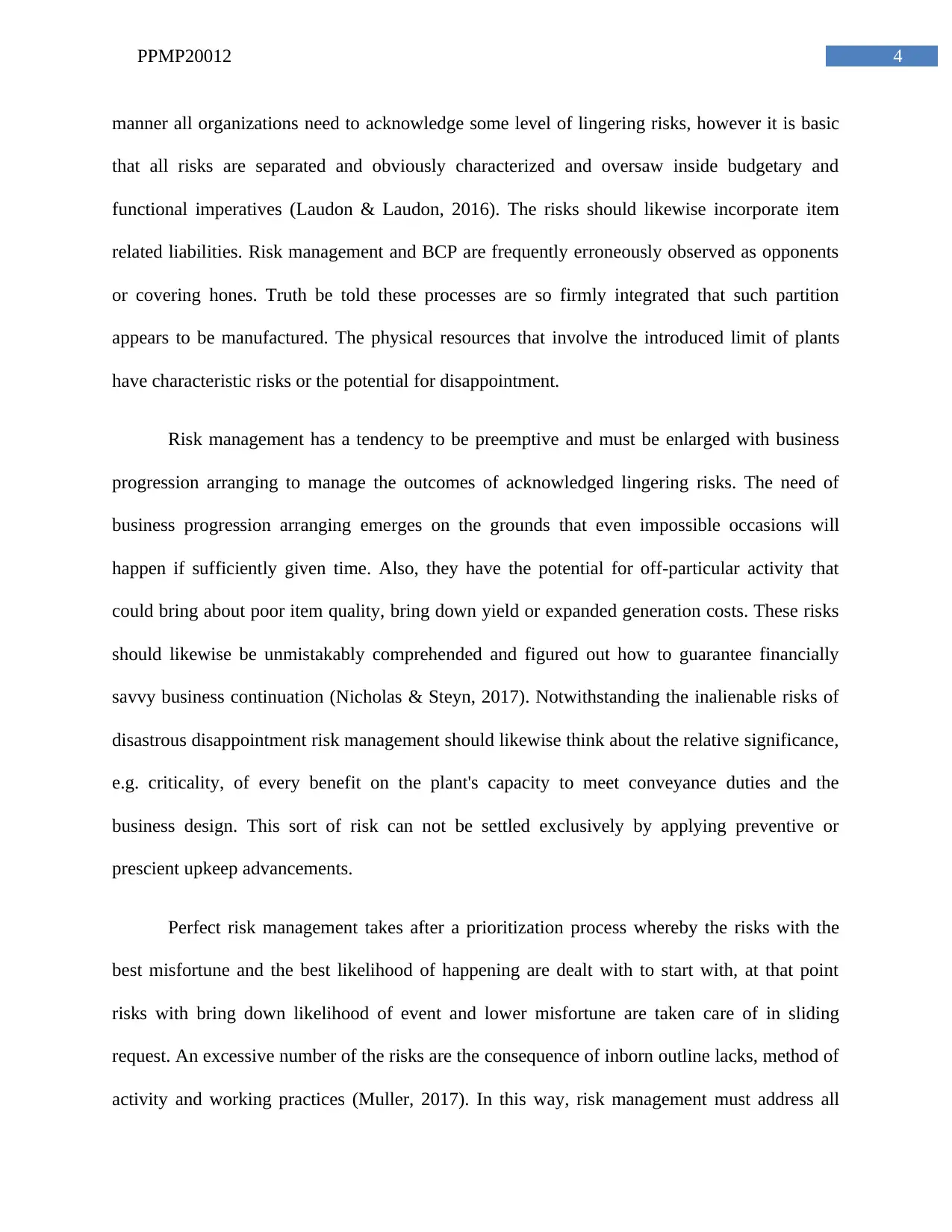
4PPMP20012
manner all organizations need to acknowledge some level of lingering risks, however it is basic
that all risks are separated and obviously characterized and oversaw inside budgetary and
functional imperatives (Laudon & Laudon, 2016). The risks should likewise incorporate item
related liabilities. Risk management and BCP are frequently erroneously observed as opponents
or covering hones. Truth be told these processes are so firmly integrated that such partition
appears to be manufactured. The physical resources that involve the introduced limit of plants
have characteristic risks or the potential for disappointment.
Risk management has a tendency to be preemptive and must be enlarged with business
progression arranging to manage the outcomes of acknowledged lingering risks. The need of
business progression arranging emerges on the grounds that even impossible occasions will
happen if sufficiently given time. Also, they have the potential for off-particular activity that
could bring about poor item quality, bring down yield or expanded generation costs. These risks
should likewise be unmistakably comprehended and figured out how to guarantee financially
savvy business continuation (Nicholas & Steyn, 2017). Notwithstanding the inalienable risks of
disastrous disappointment risk management should likewise think about the relative significance,
e.g. criticality, of every benefit on the plant's capacity to meet conveyance duties and the
business design. This sort of risk can not be settled exclusively by applying preventive or
prescient upkeep advancements.
Perfect risk management takes after a prioritization process whereby the risks with the
best misfortune and the best likelihood of happening are dealt with to start with, at that point
risks with bring down likelihood of event and lower misfortune are taken care of in sliding
request. An excessive number of the risks are the consequence of inborn outline lacks, method of
activity and working practices (Muller, 2017). In this way, risk management must address all
manner all organizations need to acknowledge some level of lingering risks, however it is basic
that all risks are separated and obviously characterized and oversaw inside budgetary and
functional imperatives (Laudon & Laudon, 2016). The risks should likewise incorporate item
related liabilities. Risk management and BCP are frequently erroneously observed as opponents
or covering hones. Truth be told these processes are so firmly integrated that such partition
appears to be manufactured. The physical resources that involve the introduced limit of plants
have characteristic risks or the potential for disappointment.
Risk management has a tendency to be preemptive and must be enlarged with business
progression arranging to manage the outcomes of acknowledged lingering risks. The need of
business progression arranging emerges on the grounds that even impossible occasions will
happen if sufficiently given time. Also, they have the potential for off-particular activity that
could bring about poor item quality, bring down yield or expanded generation costs. These risks
should likewise be unmistakably comprehended and figured out how to guarantee financially
savvy business continuation (Nicholas & Steyn, 2017). Notwithstanding the inalienable risks of
disastrous disappointment risk management should likewise think about the relative significance,
e.g. criticality, of every benefit on the plant's capacity to meet conveyance duties and the
business design. This sort of risk can not be settled exclusively by applying preventive or
prescient upkeep advancements.
Perfect risk management takes after a prioritization process whereby the risks with the
best misfortune and the best likelihood of happening are dealt with to start with, at that point
risks with bring down likelihood of event and lower misfortune are taken care of in sliding
request. An excessive number of the risks are the consequence of inborn outline lacks, method of
activity and working practices (Muller, 2017). In this way, risk management must address all
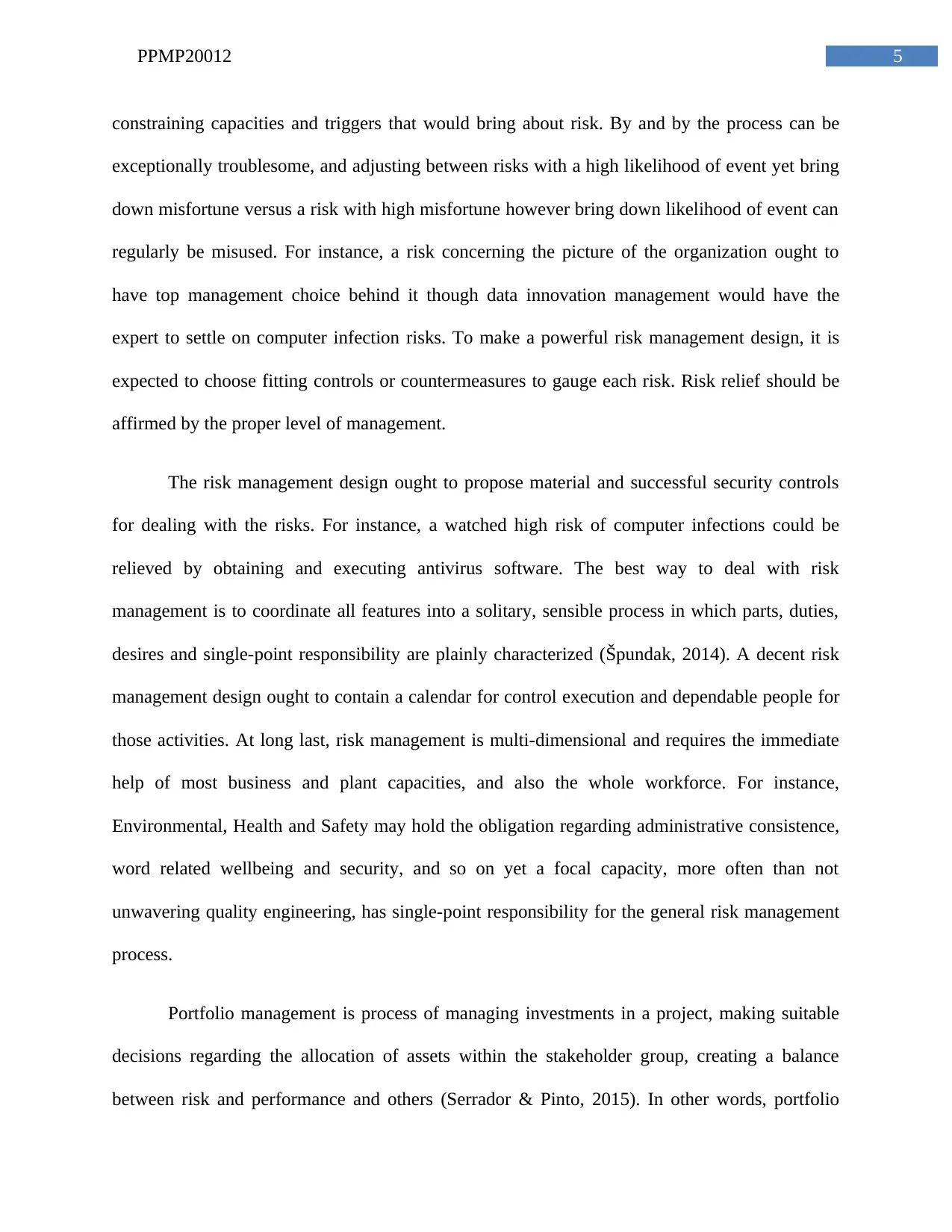
5PPMP20012
constraining capacities and triggers that would bring about risk. By and by the process can be
exceptionally troublesome, and adjusting between risks with a high likelihood of event yet bring
down misfortune versus a risk with high misfortune however bring down likelihood of event can
regularly be misused. For instance, a risk concerning the picture of the organization ought to
have top management choice behind it though data innovation management would have the
expert to settle on computer infection risks. To make a powerful risk management design, it is
expected to choose fitting controls or countermeasures to gauge each risk. Risk relief should be
affirmed by the proper level of management.
The risk management design ought to propose material and successful security controls
for dealing with the risks. For instance, a watched high risk of computer infections could be
relieved by obtaining and executing antivirus software. The best way to deal with risk
management is to coordinate all features into a solitary, sensible process in which parts, duties,
desires and single-point responsibility are plainly characterized (Špundak, 2014). A decent risk
management design ought to contain a calendar for control execution and dependable people for
those activities. At long last, risk management is multi-dimensional and requires the immediate
help of most business and plant capacities, and also the whole workforce. For instance,
Environmental, Health and Safety may hold the obligation regarding administrative consistence,
word related wellbeing and security, and so on yet a focal capacity, more often than not
unwavering quality engineering, has single-point responsibility for the general risk management
process.
Portfolio management is process of managing investments in a project, making suitable
decisions regarding the allocation of assets within the stakeholder group, creating a balance
between risk and performance and others (Serrador & Pinto, 2015). In other words, portfolio
constraining capacities and triggers that would bring about risk. By and by the process can be
exceptionally troublesome, and adjusting between risks with a high likelihood of event yet bring
down misfortune versus a risk with high misfortune however bring down likelihood of event can
regularly be misused. For instance, a risk concerning the picture of the organization ought to
have top management choice behind it though data innovation management would have the
expert to settle on computer infection risks. To make a powerful risk management design, it is
expected to choose fitting controls or countermeasures to gauge each risk. Risk relief should be
affirmed by the proper level of management.
The risk management design ought to propose material and successful security controls
for dealing with the risks. For instance, a watched high risk of computer infections could be
relieved by obtaining and executing antivirus software. The best way to deal with risk
management is to coordinate all features into a solitary, sensible process in which parts, duties,
desires and single-point responsibility are plainly characterized (Špundak, 2014). A decent risk
management design ought to contain a calendar for control execution and dependable people for
those activities. At long last, risk management is multi-dimensional and requires the immediate
help of most business and plant capacities, and also the whole workforce. For instance,
Environmental, Health and Safety may hold the obligation regarding administrative consistence,
word related wellbeing and security, and so on yet a focal capacity, more often than not
unwavering quality engineering, has single-point responsibility for the general risk management
process.
Portfolio management is process of managing investments in a project, making suitable
decisions regarding the allocation of assets within the stakeholder group, creating a balance
between risk and performance and others (Serrador & Pinto, 2015). In other words, portfolio
⊘ This is a preview!⊘
Do you want full access?
Subscribe today to unlock all pages.

Trusted by 1+ million students worldwide
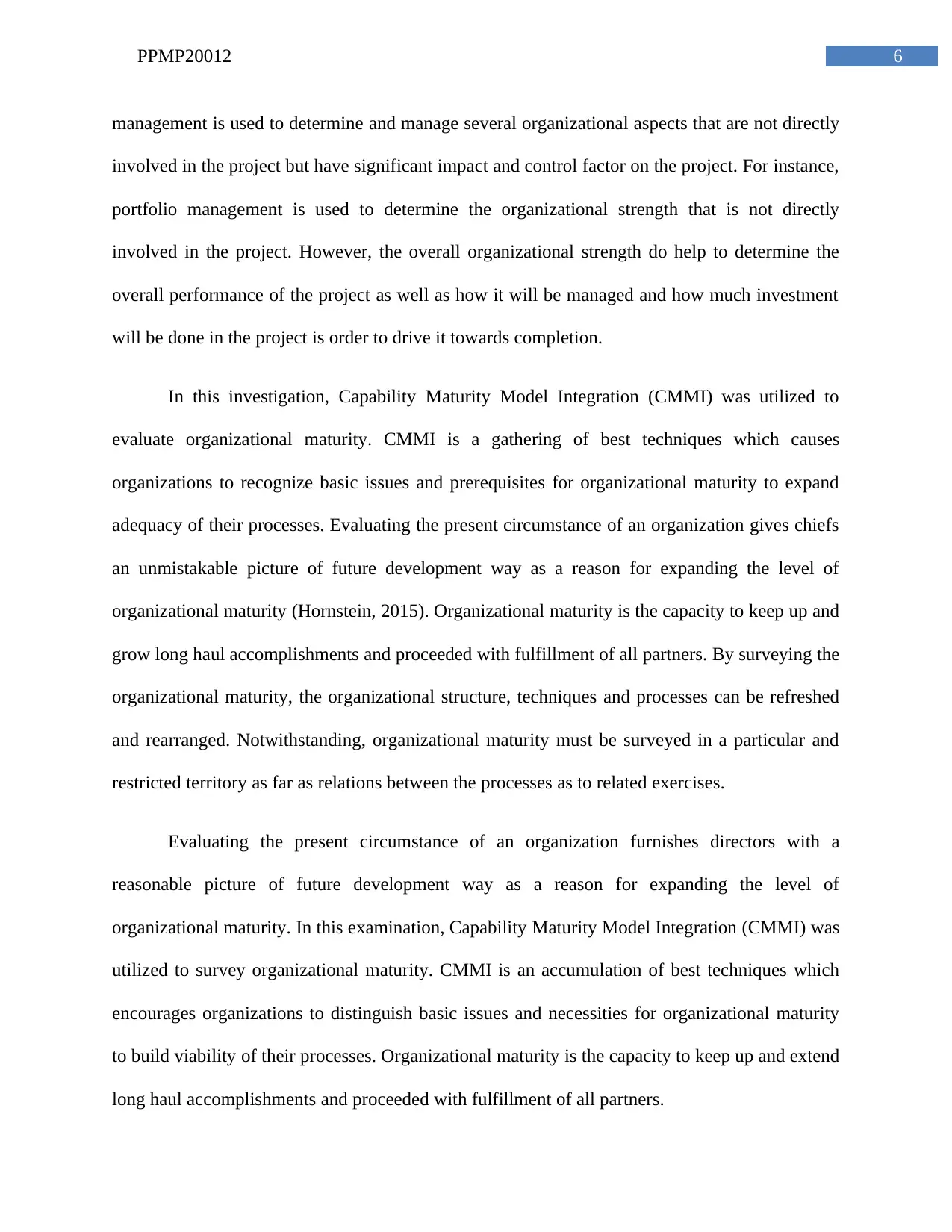
6PPMP20012
management is used to determine and manage several organizational aspects that are not directly
involved in the project but have significant impact and control factor on the project. For instance,
portfolio management is used to determine the organizational strength that is not directly
involved in the project. However, the overall organizational strength do help to determine the
overall performance of the project as well as how it will be managed and how much investment
will be done in the project is order to drive it towards completion.
In this investigation, Capability Maturity Model Integration (CMMI) was utilized to
evaluate organizational maturity. CMMI is a gathering of best techniques which causes
organizations to recognize basic issues and prerequisites for organizational maturity to expand
adequacy of their processes. Evaluating the present circumstance of an organization gives chiefs
an unmistakable picture of future development way as a reason for expanding the level of
organizational maturity (Hornstein, 2015). Organizational maturity is the capacity to keep up and
grow long haul accomplishments and proceeded with fulfillment of all partners. By surveying the
organizational maturity, the organizational structure, techniques and processes can be refreshed
and rearranged. Notwithstanding, organizational maturity must be surveyed in a particular and
restricted territory as far as relations between the processes as to related exercises.
Evaluating the present circumstance of an organization furnishes directors with a
reasonable picture of future development way as a reason for expanding the level of
organizational maturity. In this examination, Capability Maturity Model Integration (CMMI) was
utilized to survey organizational maturity. CMMI is an accumulation of best techniques which
encourages organizations to distinguish basic issues and necessities for organizational maturity
to build viability of their processes. Organizational maturity is the capacity to keep up and extend
long haul accomplishments and proceeded with fulfillment of all partners.
management is used to determine and manage several organizational aspects that are not directly
involved in the project but have significant impact and control factor on the project. For instance,
portfolio management is used to determine the organizational strength that is not directly
involved in the project. However, the overall organizational strength do help to determine the
overall performance of the project as well as how it will be managed and how much investment
will be done in the project is order to drive it towards completion.
In this investigation, Capability Maturity Model Integration (CMMI) was utilized to
evaluate organizational maturity. CMMI is a gathering of best techniques which causes
organizations to recognize basic issues and prerequisites for organizational maturity to expand
adequacy of their processes. Evaluating the present circumstance of an organization gives chiefs
an unmistakable picture of future development way as a reason for expanding the level of
organizational maturity (Hornstein, 2015). Organizational maturity is the capacity to keep up and
grow long haul accomplishments and proceeded with fulfillment of all partners. By surveying the
organizational maturity, the organizational structure, techniques and processes can be refreshed
and rearranged. Notwithstanding, organizational maturity must be surveyed in a particular and
restricted territory as far as relations between the processes as to related exercises.
Evaluating the present circumstance of an organization furnishes directors with a
reasonable picture of future development way as a reason for expanding the level of
organizational maturity. In this examination, Capability Maturity Model Integration (CMMI) was
utilized to survey organizational maturity. CMMI is an accumulation of best techniques which
encourages organizations to distinguish basic issues and necessities for organizational maturity
to build viability of their processes. Organizational maturity is the capacity to keep up and extend
long haul accomplishments and proceeded with fulfillment of all partners.
Paraphrase This Document
Need a fresh take? Get an instant paraphrase of this document with our AI Paraphraser
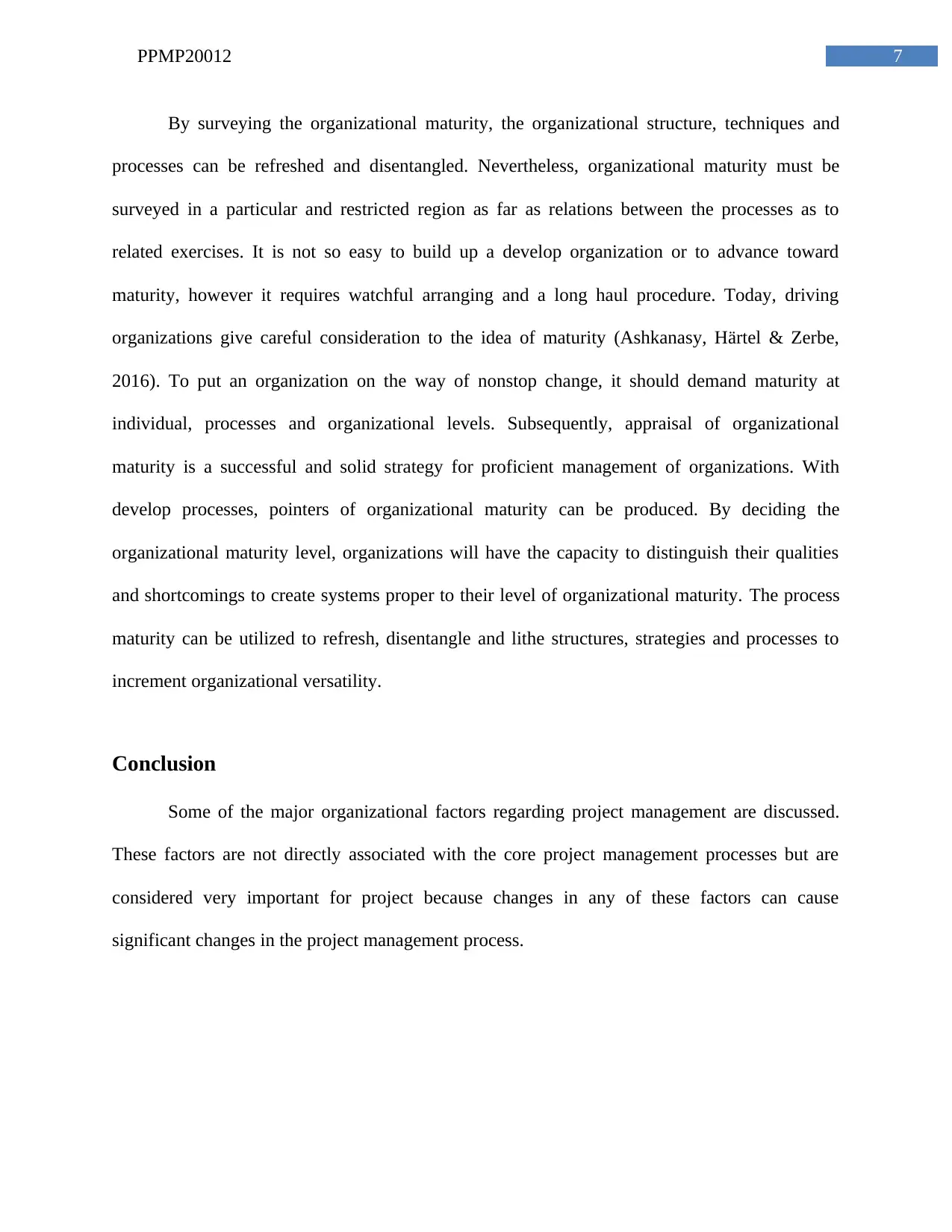
7PPMP20012
By surveying the organizational maturity, the organizational structure, techniques and
processes can be refreshed and disentangled. Nevertheless, organizational maturity must be
surveyed in a particular and restricted region as far as relations between the processes as to
related exercises. It is not so easy to build up a develop organization or to advance toward
maturity, however it requires watchful arranging and a long haul procedure. Today, driving
organizations give careful consideration to the idea of maturity (Ashkanasy, Härtel & Zerbe,
2016). To put an organization on the way of nonstop change, it should demand maturity at
individual, processes and organizational levels. Subsequently, appraisal of organizational
maturity is a successful and solid strategy for proficient management of organizations. With
develop processes, pointers of organizational maturity can be produced. By deciding the
organizational maturity level, organizations will have the capacity to distinguish their qualities
and shortcomings to create systems proper to their level of organizational maturity. The process
maturity can be utilized to refresh, disentangle and lithe structures, strategies and processes to
increment organizational versatility.
Conclusion
Some of the major organizational factors regarding project management are discussed.
These factors are not directly associated with the core project management processes but are
considered very important for project because changes in any of these factors can cause
significant changes in the project management process.
By surveying the organizational maturity, the organizational structure, techniques and
processes can be refreshed and disentangled. Nevertheless, organizational maturity must be
surveyed in a particular and restricted region as far as relations between the processes as to
related exercises. It is not so easy to build up a develop organization or to advance toward
maturity, however it requires watchful arranging and a long haul procedure. Today, driving
organizations give careful consideration to the idea of maturity (Ashkanasy, Härtel & Zerbe,
2016). To put an organization on the way of nonstop change, it should demand maturity at
individual, processes and organizational levels. Subsequently, appraisal of organizational
maturity is a successful and solid strategy for proficient management of organizations. With
develop processes, pointers of organizational maturity can be produced. By deciding the
organizational maturity level, organizations will have the capacity to distinguish their qualities
and shortcomings to create systems proper to their level of organizational maturity. The process
maturity can be utilized to refresh, disentangle and lithe structures, strategies and processes to
increment organizational versatility.
Conclusion
Some of the major organizational factors regarding project management are discussed.
These factors are not directly associated with the core project management processes but are
considered very important for project because changes in any of these factors can cause
significant changes in the project management process.
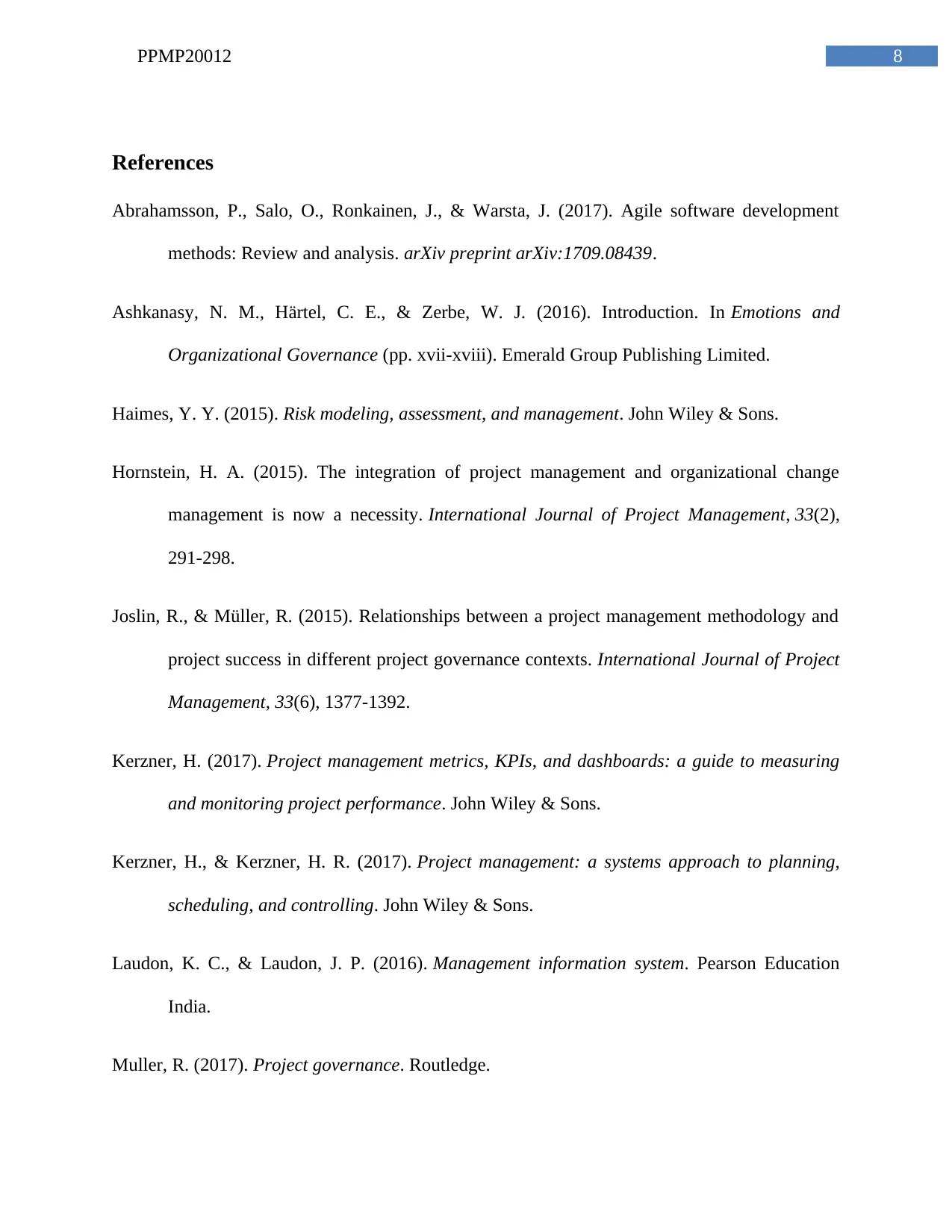
8PPMP20012
References
Abrahamsson, P., Salo, O., Ronkainen, J., & Warsta, J. (2017). Agile software development
methods: Review and analysis. arXiv preprint arXiv:1709.08439.
Ashkanasy, N. M., Härtel, C. E., & Zerbe, W. J. (2016). Introduction. In Emotions and
Organizational Governance (pp. xvii-xviii). Emerald Group Publishing Limited.
Haimes, Y. Y. (2015). Risk modeling, assessment, and management. John Wiley & Sons.
Hornstein, H. A. (2015). The integration of project management and organizational change
management is now a necessity. International Journal of Project Management, 33(2),
291-298.
Joslin, R., & Müller, R. (2015). Relationships between a project management methodology and
project success in different project governance contexts. International Journal of Project
Management, 33(6), 1377-1392.
Kerzner, H. (2017). Project management metrics, KPIs, and dashboards: a guide to measuring
and monitoring project performance. John Wiley & Sons.
Kerzner, H., & Kerzner, H. R. (2017). Project management: a systems approach to planning,
scheduling, and controlling. John Wiley & Sons.
Laudon, K. C., & Laudon, J. P. (2016). Management information system. Pearson Education
India.
Muller, R. (2017). Project governance. Routledge.
References
Abrahamsson, P., Salo, O., Ronkainen, J., & Warsta, J. (2017). Agile software development
methods: Review and analysis. arXiv preprint arXiv:1709.08439.
Ashkanasy, N. M., Härtel, C. E., & Zerbe, W. J. (2016). Introduction. In Emotions and
Organizational Governance (pp. xvii-xviii). Emerald Group Publishing Limited.
Haimes, Y. Y. (2015). Risk modeling, assessment, and management. John Wiley & Sons.
Hornstein, H. A. (2015). The integration of project management and organizational change
management is now a necessity. International Journal of Project Management, 33(2),
291-298.
Joslin, R., & Müller, R. (2015). Relationships between a project management methodology and
project success in different project governance contexts. International Journal of Project
Management, 33(6), 1377-1392.
Kerzner, H. (2017). Project management metrics, KPIs, and dashboards: a guide to measuring
and monitoring project performance. John Wiley & Sons.
Kerzner, H., & Kerzner, H. R. (2017). Project management: a systems approach to planning,
scheduling, and controlling. John Wiley & Sons.
Laudon, K. C., & Laudon, J. P. (2016). Management information system. Pearson Education
India.
Muller, R. (2017). Project governance. Routledge.
⊘ This is a preview!⊘
Do you want full access?
Subscribe today to unlock all pages.

Trusted by 1+ million students worldwide
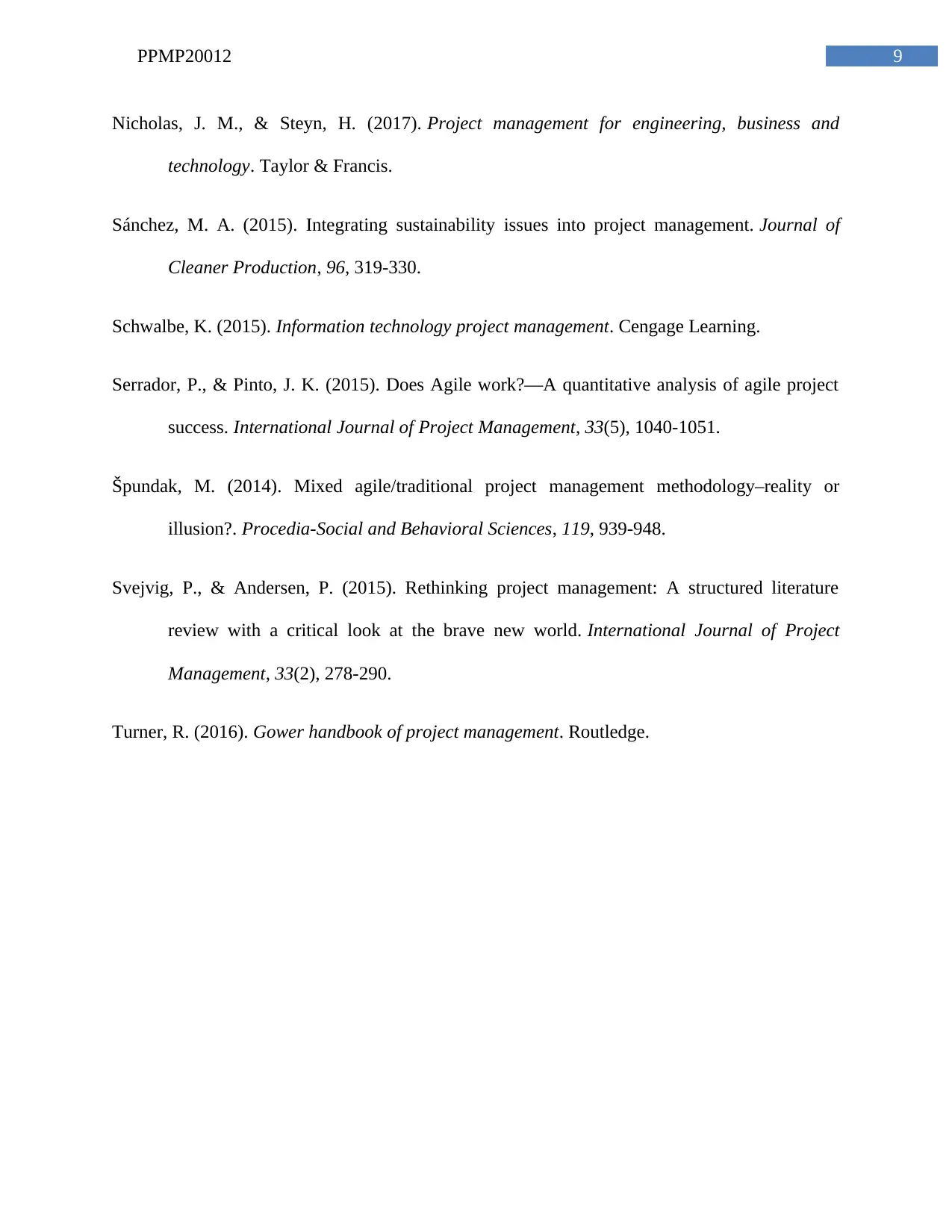
9PPMP20012
Nicholas, J. M., & Steyn, H. (2017). Project management for engineering, business and
technology. Taylor & Francis.
Sánchez, M. A. (2015). Integrating sustainability issues into project management. Journal of
Cleaner Production, 96, 319-330.
Schwalbe, K. (2015). Information technology project management. Cengage Learning.
Serrador, P., & Pinto, J. K. (2015). Does Agile work?—A quantitative analysis of agile project
success. International Journal of Project Management, 33(5), 1040-1051.
Špundak, M. (2014). Mixed agile/traditional project management methodology–reality or
illusion?. Procedia-Social and Behavioral Sciences, 119, 939-948.
Svejvig, P., & Andersen, P. (2015). Rethinking project management: A structured literature
review with a critical look at the brave new world. International Journal of Project
Management, 33(2), 278-290.
Turner, R. (2016). Gower handbook of project management. Routledge.
Nicholas, J. M., & Steyn, H. (2017). Project management for engineering, business and
technology. Taylor & Francis.
Sánchez, M. A. (2015). Integrating sustainability issues into project management. Journal of
Cleaner Production, 96, 319-330.
Schwalbe, K. (2015). Information technology project management. Cengage Learning.
Serrador, P., & Pinto, J. K. (2015). Does Agile work?—A quantitative analysis of agile project
success. International Journal of Project Management, 33(5), 1040-1051.
Špundak, M. (2014). Mixed agile/traditional project management methodology–reality or
illusion?. Procedia-Social and Behavioral Sciences, 119, 939-948.
Svejvig, P., & Andersen, P. (2015). Rethinking project management: A structured literature
review with a critical look at the brave new world. International Journal of Project
Management, 33(2), 278-290.
Turner, R. (2016). Gower handbook of project management. Routledge.
1 out of 10
Related Documents
Your All-in-One AI-Powered Toolkit for Academic Success.
+13062052269
info@desklib.com
Available 24*7 on WhatsApp / Email
![[object Object]](/_next/static/media/star-bottom.7253800d.svg)
Unlock your academic potential
Copyright © 2020–2025 A2Z Services. All Rights Reserved. Developed and managed by ZUCOL.




